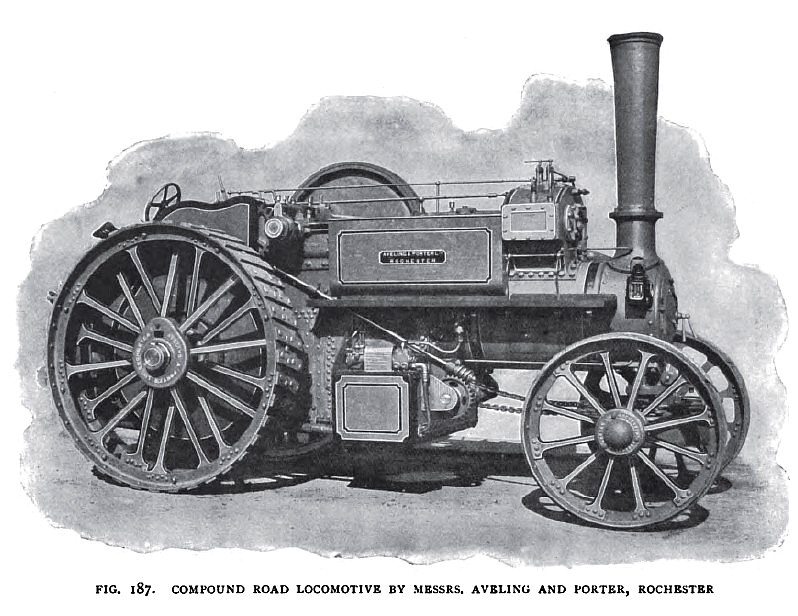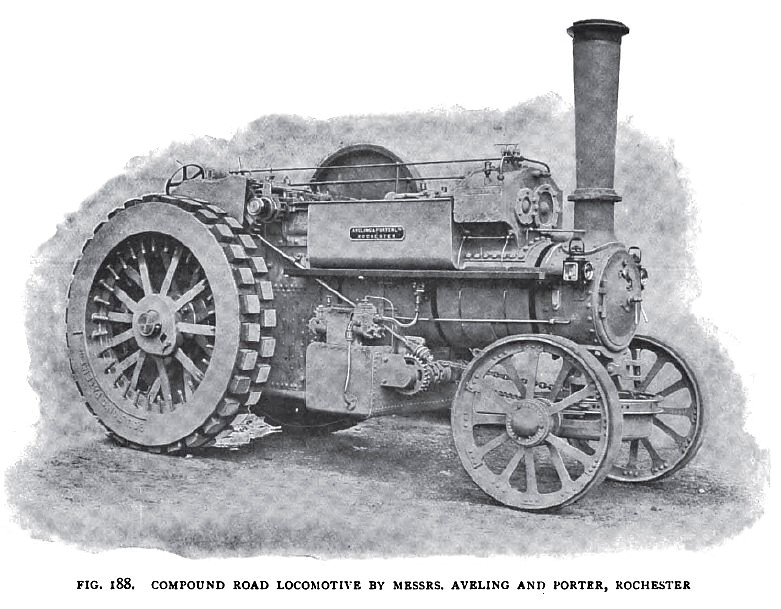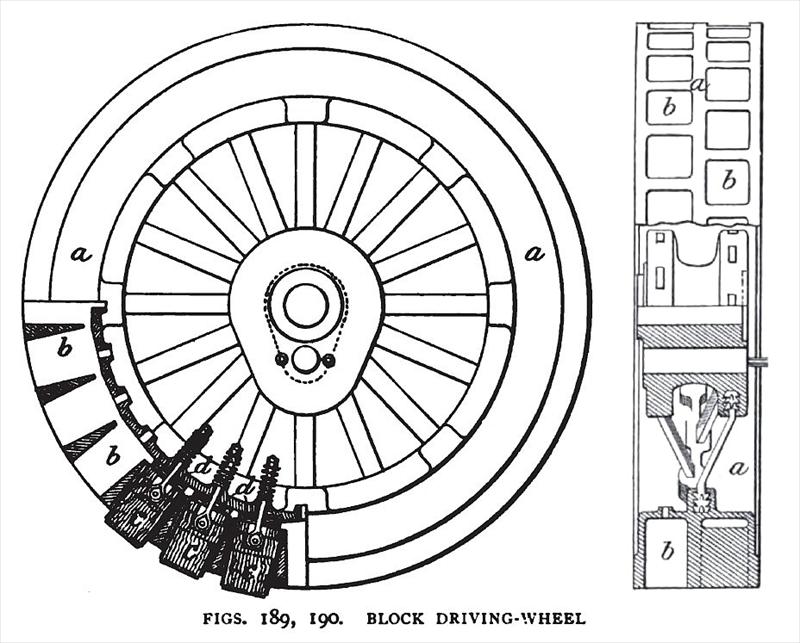|
Title: |
1904 Article-Aveling & Porter, Compound Steam Road Locomotive |
|
Source: |
English and American Steam Carriages and Traction Engines 1904 pg 298 |
|
Insert Date: |
8/15/2011 12:59:48 PM |
MESSRS. AVELING AND PORTER
The illustration, Fig. 187, represents a newly designed compound road locomotive mounted on laminated springs; the compound cylinders are placed side by side with outside valve chests. An auxiliary .valve is fitted to admit high-pressure steam to the low-pressure steam chest for starting when the high-pressure crank is on the dead centre. The double-throw crank-shaft is cut from the solid ingot; some part of the gearing is placed between the side plates of the fire-box shell, which are carried upward and backward in one piece so as to support the crank-shaft, counter-shaft, and driving-axle in the most convenient position. Three pinions are employed in the compensating gear mounted on the driving-axle. A disc flywheel is provided. The woodblock brakes act on the insides of the tires of the driving-wheels, and are actuated from the foot-plate. An additional tank is carried beneath the barrel of the boiler, connected to the hind tank by means of a pipe of large diameter. On this tank a steam pump is mounted for feeding the boiler, as shown. A winding-drum is fitted on the hind axle, carrying 75 yards of steel wire rope, with brackets and guide rollers fitted on the tender. The water-lifter for filling the tanks is provided with 26 feet of India-rubber suction hose. The boiler is tested by hydraulic pressure to 300 lbs. per square inch for a working pressure of 180 lbs. The engine is fitted with two speeds. A rack is arranged round the coal bunker. The engine is mounted on an improved arrangement of laminated steel springs to both the hind and front axles, by which the springs come into operation at whatever position the road wheels may be in. Sheet steel casing plates are placed round the working parts, as shown in the illustration. Fig. 188 represents another road locomotive built by Messrs. Aveling and Porter, fitted with Boulton's woodblock wheels; these are illustrated in Figs. 189 and 190. The sections of the wheel show the construction clearly; but the following description taken from Mr. McLaren's paper may be inserted :—
"The wheel has been brought out by Messrs. J. and H. McLaren and the late Mr. J. W. Boulton. It is being manufactured by Messrs. Aveling and Porter, and Messrs. J. and H. McLaren. It has a broad cast-iron rim a, with cells or slots b, about 6 inches square, cast all round its circumference. These cells are 6 or 8 inches deep, closed at the bottom, but opened towards the outside of the periphery of the wheel. A hard wood block c cut lengthwise of the grain, is fitted loosely into each cell, one end projecting a little beyond the rim of the wheel, and the other bearing upon an elastic pad or buffer d between it and the bottom of the cell. A suitable provision is made to prevent the blocks from dropping out as the wheels revolve. When the engine is in motion the weight upon the rim of the wheel compresses the blocks so that those in the lowest and adjoining cells come in contact with the road at the same time, forming a large and continuous flat tread to the wheel, and so increasing its adhesion on the road. On paved streets the use of these wheels is specially advantageous, for not only is the tractive power of the engine enormously increased, but any possible damage to the paving setts, caused by the chipping action of ordinary wheels, is entirely avoided." Respecting the compound engines it is said: "The additional cost is not a serious one, and is very soon repaid by the economy in fuel it ensures; for in it the steam is used twice over, first in the high and afterwards in the low-pressure cylinder, and is not discharged through the exhaust until its pressure has been reduced almost to that of the atmosphere itself. In other words, there is more duty obtained from the steam in a compound engine than in a single-cylinder engine for the same expenditure of fuel. Another advantage of the compound engine is that of its subduing the noise of the exhaust when at work; for perhaps in no class of engine is silent working more essential than for a road locomotive, seeing that their use is chiefly in towns or on busy suburban roads. The comparative noiselessness is due to the low pressure at which the steam is discharged into the atmosphere." |
|
 1904 Aveling & Porter, Compound Steam Road Locomotive
1904 Aveling & Porter, Compound Steam Road Locomotive
 1904 Aveling & Porter, Compound Steam Road Locomotive
1904 Aveling & Porter, Compound Steam Road Locomotive
 1904 Aveling & Porter, Compound Steam Road Locomotive Block Driving Wheel
1904 Aveling & Porter, Compound Steam Road Locomotive Block Driving Wheel
|
|